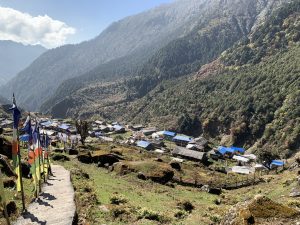A man from Biratnagar in southeastern Nepal can marry a woman from Beijing in China, just as a man from China’s Kunming city can wed a woman from Kathmandu in Nepal. Beijing does not seem to have a problem with long-distance cross-border marriages.
However, it has forbidden cross-border marriages between people who live in the Sino-Nepali borderlands, within walking distance of each other, and with strong linguistic and cultural ties. Beijing has provided no explanation for this policy.
During my recent trek in Olangchung Gola village of Nepal’s far eastern Taplejung district, which borders both of Nepal’s neighbors, China and India, I found that cross-border marriages, once the norm in Olangchung Gola, are now a rarity.
At Olangchung Gola, a Himalayan village of 55 households, I met Chumbe Sherpa, an elderly Nepali man with four wives. His first wife, with whom he eloped in 1962, was from Tibet.

Chumbe Sherpa’s first wife was from Tibet. Photo by Birat Anupam.
However, nowadays, a Nepali in the borderlands cannot marry a Tibetan. Nepali men can no longer be sons-in-law of China’s Tibet Autonomous Region (TAR).
“Cross-border marriage was not an issue until 2008,” a Nepali local in Olangchung Gola told The Diplomat. It was “halted from the Chinese side after 2012.”
According to Chumbe Sherpa, who is a former deputy chair of the erstwhile Olangchung Gola Village Development Committee (local government), previously Tibetan women were drawn to Nepal as Nepal was comparatively well-developed and the source of their food and other supplies. A marriage with a Nepali man was therefore an attractive option.
However, in more recent decades, China has developed the Tibetan region, and the Tibetan border regions are more developed than the Nepali ones. The situation has reversed and commodities now flow into Nepal from Riu in Dinggye County of the TAR. Almost all daily essentials being used by residents of Olangchung Gola are from TAR and sport Mandarin characters. Olanchung Gola is closer to Riu bazaar than Taplejung’s district headquarters of Phungling bazaar.
Even meeting relatives on the Chinese side of the Sino-Nepali border has become tougher post-pandemic. “We can’t go to our relatives’ homes on the other side,” Chhilamo Lama, whose maternal house is on the Chinese side said, pointing out that she has “to stay at a quarantine-like home,” where her “relatives come to meet and greet” her. “This was not the case in the past,” she said.
At Olangchung Gola, I saw people engaging in cross-border trade with China, which is just around 25 kilometers away.
Local residents as well as security personnel view the Chinese positively. Madhab Khatri, the recently deployed Border Outpost chief of Nepal’s Armed Police Force said, “Chinese counterparts often ask if we need anything from them.”
“We mostly go to Riu to sell our products and buy theirs. If we can’t sell all our products in the Riu bazaar, Chinese policemen purchase our unsold items,” Chhilamo Lama told The Diplomat.
Chheten Sherpa, a local leader of the Nepali Congress and a former local government member, said that the Chinese are helpful and are eager to have better road connectivity with Nepal. Chinese-sent bulldozers and oil tankers with Chinese number plates are visible at Olangchung Gola bazaar.
People from both sides of the Sino-Nepali border share a Buddhist cultural heritage and linguistic ties. Still, cross-border marriage doesn’t exist anymore. The centuries-old borderlands marriage has been halted thanks to the Chinese side.
Yet Chinese leaders have waxed eloquent on the strong bonds, including matrimonial ties, between the people of the two countries. In a signed article written ahead of his Nepal visit in 2019, Chinese President Xi Jinping noted, “In China’s Tang Dynasty (618-907), Nepali Princess Bhrikuti was married to Tibetan King Songtsen Gampo, while the Chinese monk Huen Tsang visited Lumbini, the birthplace of the Buddha, and left many precious written accounts of his pilgrimage.”
“The Himalayas soaring between our two countries have not blocked the friendly contacts between our two peoples,” Chinese Prime Minister Zhou Enlai said at the Kathmandu Civic Reception during his visit to Nepal in April 1960.
Cross-border movement of people and goods, which was halted during the COVID-19 pandemic, was resumed recently. On May 25, Nepal and China reopened 14 traditional border crossings, including Olangchung Gola, in the presence of top leaders including Nepal’s Deputy Prime Minister and Minister for Foreign Affairs Narayan Kaji Shrestha and Vice Chairman of China’s Tibet Autonomous Region Silang Nima.
When border trade and crossings have resumed, why are traditional borderland marriages being blocked? Why are marriages between people who have to fly long distances across the Himalayas permitted when those who live just walking distance of each other are forbidden?
Beijing has not explained its strange policy.

































